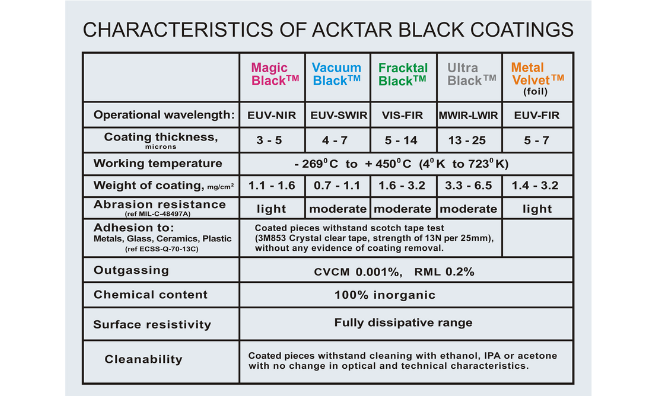Acktar’s proprietary sophisticated vacuum deposition (vacuum coating) technology generates coatings with an extremely high specific surface area. Discover the unique characteristics of our vacuum coating technology.
Suppress stray light in high-performance optics easily and efficiently using our advanced optical black coatings, in the ultra-violet, visible and infra-red wavelengths spectrums.
Combining extremely low reflectance and high absorptance with high thermal stability, high emissivity, very low outgassing and excellent adhesion to essentially all materials in just a few microns of a coating.
Your new optical coating is just a few clicks away!
Suits most engineering materials and components for night vision systems, cooled Iinfrared detector parts, LED screens, microscopes lenses, spectrometers, satellite equipment, solar panels, optical clocks and more.


Acktar’s proprietary sophisticated vacuum deposition (vacuum coating) technology generates coatings with an extremely high specific surface area. Discover the unique characteristics of our vacuum coating technology.
Acktar’s black coatings are manufactured using vacuum deposition technology. They are very thin, completely inorganic, have very low outgassing and low reflectivity. See our video here.
The table below provides a detailed comparison of Acktar’s black coatings with typical paint coatings.
Comparison Table
| Characteristic | Paint – typical | Acktar |
| Coating Density | 1.1 gr/cm3 | 1.8 gr/cm3 |
| Coating Thickness | µm-100µm 60 | 10 ~ µm |
| Coating weight | 10.8 mg/cm2 dry | 0.9 mg/cm2 |
| Coating Reflectance (0.8-12µm) | < 10% | < 4% |
| Coating Outgassing- CVCM | < 0.1% | 0,001% |
| Coating Outgassing – RML | < 1% | 0.3% |
| Bonding to coating | problematic | excellent |
| Coating Edges | build-up on edges/corners | not build up |
| Coating Drying period | 7 days | none |
| Coating Temperature range | 96K-473K | 4K-623K (720K for short periods) |
| Coating Particulate contamination | particulates | not particulates |
| Coating Organic contamination (silicones, polymers, etc.) | high | none |
| Coating thickness control | poor | good |
| Coating Thickness tolerance | ±20µm | ±1.5µm |
| Coating adhesion | limited | excellent |
| Coating Resistance to atomic oxygen | limited | excellent |
| Coating Electrical conductivity | typically non-conductive | tailorable conductivity |
Acktar’s black coatings are typically between 3-14 µm thick, but can be tailored to between 1-30µm upon request.
No Particulation, broad working temperature range, low outgassing, thin coating with tight tolerances, low reflectivity over a wide wavelength range, high emissivity, completely inorganic, can be applied on essentially any substrate, perfect cover (no build-up) on edges.
Yes, easily! We use mechanical masking that is tailored to the requirements of the coating area.
The most common applications are: stray light absorption in UV-VIS-IR wavelengths, night vision systems, cooled Infrared detector parts, satellite parts, high surface area capacitor electrodes, LED screens and more.
Acktar is certified as a production and development facility by ISO 9001:2000, IQNet, S.A.M.S, RoHs and REACH.
In addition we are certified as a “Ship to Stock” supplier for one of the world’s largest manufacturers of IR detectors – based on our quality and strict inspection regime.
See the full list of certificates.
Acktar’s coatings are available in two options:
The thickness tolerance of our black coatings can be as tight as 1-2 µm.
Acktar’s Fractal BlackTM was tested by an independent laboratory to compare its performance at very low temperatures with that of thick epoxy layers and black paint.
The summary of the report is as follows: “The main advantage of Fractal BlackTM coating for us is the relatively high blackness at low temperatures (10K-50K) of the source of the thermal radiation achieved by small thickness of the coating.”
A full copy of the report is available upon request.
Yes, our Nano Black selective coating has high absorbance in the VIS range and low emissivity in the IR range.